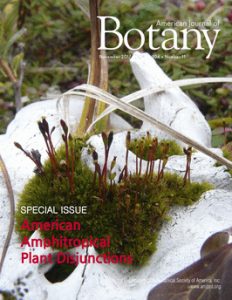 Lily Lewis published the last paper from her dissertation as an invited paper in the Special November issue of the American Journal of Botany:
Lily Lewis published the last paper from her dissertation as an invited paper in the Special November issue of the American Journal of Botany:
Lewis L.R., E.M. Biersma, S. Carey, K. Holzinger, S.F. McDaniel, R. Rozzi & B. Goffinet. 2017. Resolving the source region for the long-distance dispersal event that gave rise to the Magellanic sub-Antarctic endemic dung moss Tetraplodon fuegianus (Bryopsida: Splachnaceae). American Journal of Botany 104: 1651–1659. pdf
Abstract reads:
PREMISE OF THE STUDY: American bipolar plant distributions characterize taxa at various taxonomic ranks but are most common in the bryophytes at infra-specifi c and infrageneric levels. A previous study on the bipolar disjunction in the dung moss genus Tetraplodon found that direct long-distance dispersal from North to South in the Miocene–Pleistocene accounted for the origin of the Southern American endemic Tetraplodon fuegianus , congruent with other molecular studies on bipolar bryophytes. The previous study, however, remained inconclusive regarding a specifi c northern hemisphere source region for the transequatorial dispersal event that gave rise to T. fuegianus .
METHODS: To estimate spatial genetic structure and phylogeographic relationships within the bipolar lineage of Tetraplodon , which includes T. fuegianus , we analyzed thousands of restriction-site-associated DNA (RADseq) loci and single nucleotide polymorphisms using Bayesian individual assignment and maximum likelihood and coalescent model based phylogenetic approaches.
KEY RESULTS: Northwestern North America is the most likely source of the recent ancestor to T. fuegianus.
CONCLUSIONS: Tetraplodon fuegianus , which marks the southernmost populations in the bipolar lineage of Tetraplodon , arose following a single long-distance dispersal event involving a T. mnioides lineage that is now rare in the northern hemisphere and potentially restricted to the Pacifi c Northwest of North America. Furthermore, gene fl ow between sympatric lineages of Tetraplodon mnioides in the northern hemisphere is limited, possibly due to high rates of selfi ng or reproductive isolation.